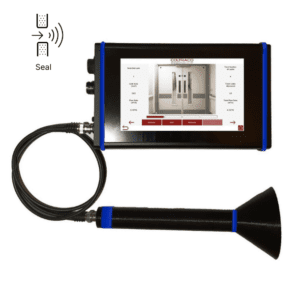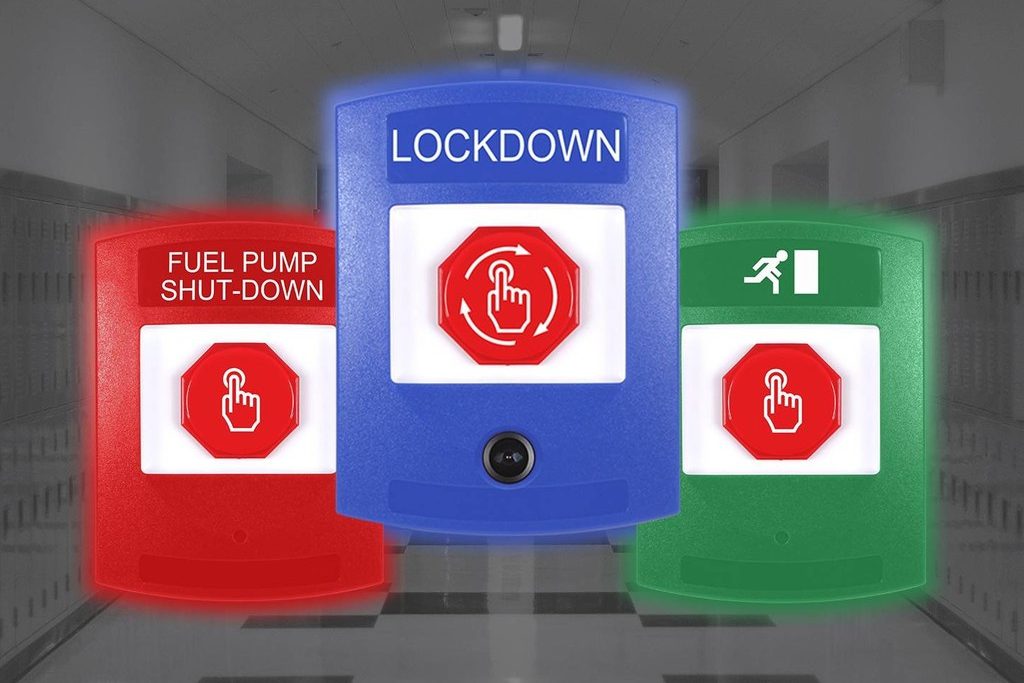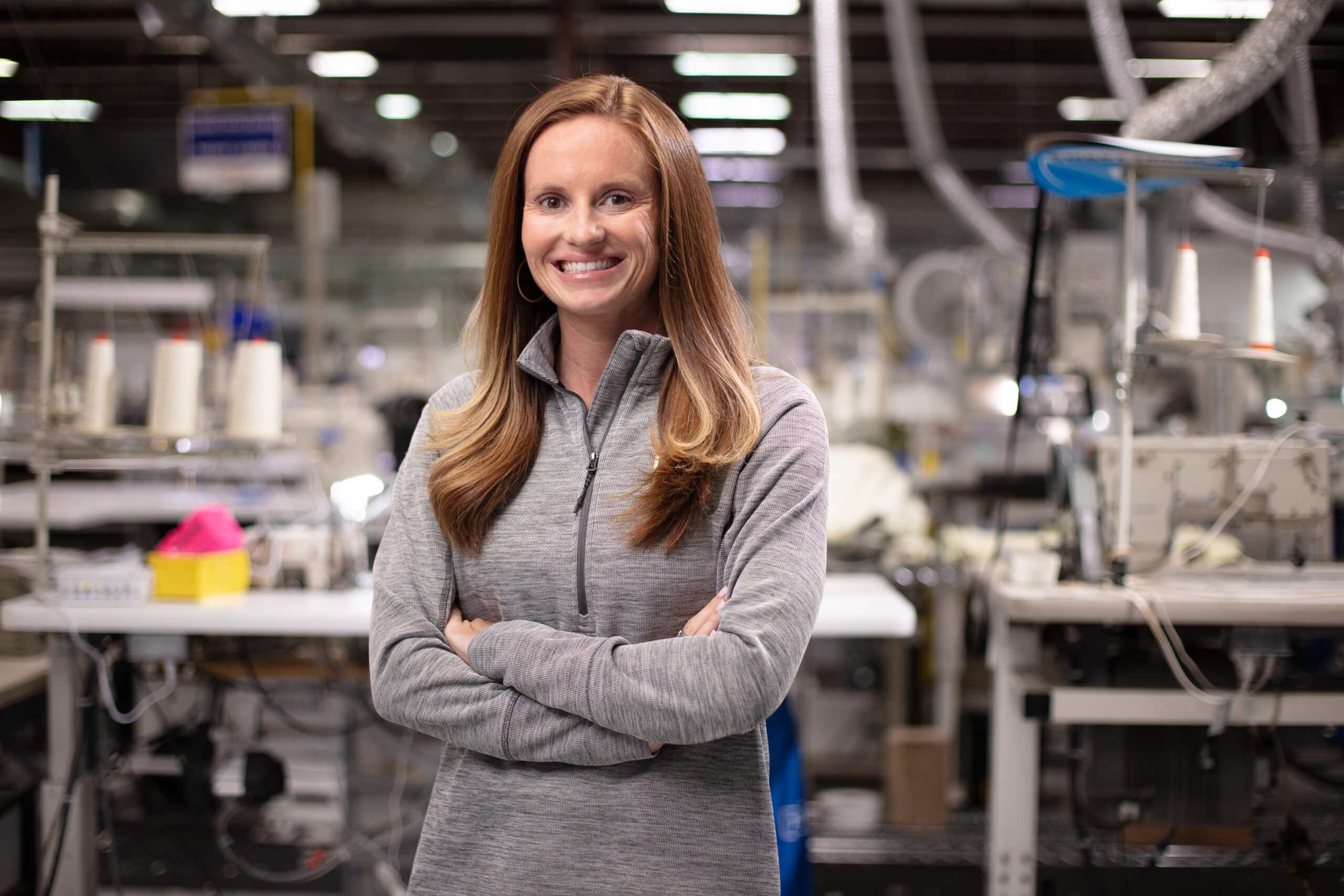The Issue & Solution
Regardless of the “air quality” within an ICU ward, minimising the airflow out of it is essential for reducing the risk of airborne contagion spread. One way this is achieved is through minimising the air permeability of a room, another is by negatively-pressurising a room which in itself cannot be effectively achieved without a suitably low air permeability value. Minimising air permeability is therefore doubly essential.
Air permeability is defined as the volume of air entering or exiting a room per hour per square metre of room envelope given a certain differential pressure, usually taken to be 50 Pa (Pascals are a unit of measure for air pressure).
Currently, when hospitals monitor the efficacy of their negative pressurisation, they do so using a pressure monitor. This tells hospital staff, providing they are checking it regularly, whether the air pressure in the ICU ward is at a suitable level. If the pressure drops below a certain level, sometimes these monitors are set up to an alarm system.
There are three problems with this:
- One is that the indication of the current pressure is not an indication of future ability to maintain that pressure.
- Secondly, if the pressure does drop, no matter how infrequently, it undermines the ability of the ward to prevent airborne infection spread and the pressure monitors provide no means of addressing that problem. If hospital staff do take action as a result of pressure drops, it is often to employ what might be called a “Patch & Hope” response.
- Thirdly, pressure monitors only measure the air pressure at a localised point in space. If the correct air pressure is found in one part of a room, this is no guarantee that it may be found elsewhere.
The hand-held, ergonomic Portascanner® COVID-19 instrument provides a capability that compliments and goes far beyond what a simple air pressure monitor can do. It allows operators to detect leakage points, meaning that they can be addressed to prevent dips in the required pressurisation which regularly occur. It also quantifies the airflow rate through leakage points and the air permeability of a room, providing surety that the room is sufficiently airtight for the FPE (Fan Pressurisation Equipment) to operate consistently. Pressure monitors cannot do these things.
According to an independent review by the Building Services Research and Information Association, reducing the air permeability of an isolation suite has a number of distinct benefits:
- A degree of passive protection is provided against contamination to or from adjacent areas.
- The ventilation system is able to be balanced and commissioned correctly.
- The pressure stabiliser can be specified accurately and can operate correctly.
- During fumigation, less fumigant will escape to adjacent areas.
- In the event of fan failure, the walls will become the first barrier against infection.
- If the leakage through the fabric is too high, the design supply and extract airflow rates may not be sufficient to pressurise the rooms or for the pressure stabiliser to operate correctly. Making up for high air permeability by increasing supply and extract flow rates is not considered desirable. A better option would be to achieve lower air permeability.
 An ICU ward is therefore far safer in terms of risk of infection spread, if the air permeability of its envelope can be quantified and if crucial leakage points can be identified and repaired. It is for this reason that Coltraco Ultrasonics won the right to a competitive government grant to innovate in this area and for this reason too that the end product has been independently declared outstanding in its field.
An ICU ward is therefore far safer in terms of risk of infection spread, if the air permeability of its envelope can be quantified and if crucial leakage points can be identified and repaired. It is for this reason that Coltraco Ultrasonics won the right to a competitive government grant to innovate in this area and for this reason too that the end product has been independently declared outstanding in its field.
A recent paper collating 24 cross-sectional studies across eight separate countries has found that significant levels of SARS-CoV-2 RNA particles were circulating in the air within 25% of ICU wards, 24% of hospital toilets, and 56% of hospital hallways. Hospitals, therefore, present a huge risk of cross-infection via airborne transmission. The most effective way to prevent airborne transmission from isolation wards is to ensure they are adequately negatively-pressurised at all times; the fact that these statistics exist, however, suggests that negative pressurisation, which might be taken for granted by hospital staff and monitored using pressure gauges, is in actuality not effectively achieved in a significant proportion of facilities, at least some of the time. This is why the Portascanner® COVID-19, as the only reasonable solution to a problem that some, but not all, are aware of, is such a breakthrough technology in reducing airborne cross-infection within the hospital sector.
The “Patch & Hope” Problem
In March 2020 the world was forced to stop, readjust, and overcome the barriers this virus has inflicted upon us all. Whilst it has sadly been a tragedy for so many people, businesses, households, and livelihoods, it has by no means stopped great British ideas, ingenuity, and innovation. The 5.9 million UK SMEs, which make up 99% of all business, generating 54% of all UK employment, have demonstrated remarkable resilience in the face of such adversity, and are at the forefront of the Government’s Levelling-Up agenda in the post-Covid-19 world that we are all so looking forward to. The NHS went into this crisis with 10,000 ICU beds. Today it is managing over 30,000.
Our NHS are struggling to bear the brunt of this virus, and the staff should not also have to constantly concern themselves with the risks of being additionally exposed to the virus. Existing taping measures are not allowing this concern to be allayed. In Intensive Care Units (ICU) the NHS has to “negatively-pressurise” each ICU Ward to prevent COVID19 infection contagion to the rest of the hospital. However, if the air permeability of ICU Wards is not sufficiently low, negative-pressurisation cannot be achieved effectively. The methods presently being undertaken to verify air permeability, are disruptive, costly and do not allow operators to identify specific areas of leakage. The maintenance teams have limited means to monitor the airflow that sustains that negative-pressurisation or identify the location and size of any specific leaks, leaving any remedial action down to mere speculation. So limited are these means that NHS personnel are forced to adopt an approach that can only be described as “Patch and Hope”.
What is the Solution?
Our Portascanner COVID-19 brings a non-invasive answer to this ‘patch and hope’ measure, and with minimal training, allows ICU personnel to locate and then quantify the leaks in hospital wards. The user can calculate the air flow rate through these leaks, generating an air permeability value for an entire ICU ward which the user can compare against the required value for negative pressurisation. Quantifying the extent of the leak, or the air permeability rate, is crucial to ensuring negative-pressurisation in order to help prevent the spread of disease. During Covid-19 maintenance of the ICU ward has never been more important, and this new hand-held instrument significantly improves the efficiency and air quality of the room, providing confidence in ability of a ward to contain the virus. Furthermore, it saves considerable time and resources in preventing FPE (fan pressurisation equipment) from being installed within an unsuitable room. The downtime required for existing test procedures is simply infeasible given the disruption to treatment this would cause in ICU wards. So, through using ultrasound, this innovation ensures minimum disruption to any room or facility, lending more time for the staff to treat their patients.
Go Above and Beyond Compliance
According to BSRIA³, the air permeability of a negatively pressurised isolation ward must not exceed 2.5m³/(h-m²) at a reference pressure of 50 Pascals. It is this value that is used in the reporting feature of the Portascanner® COVID-19. The user can provide evidence of the maintenance programme, through the camera feature, and with the tap of a finger, export a test report, all in one small portable instrument. Each leak is therefore marked and quantified in terms of the air flow rate, and its contribution to the total air permeability. This is then calculated and compared to the threshold value, whilst the cross-sectional area of the leak is also recorded. No third party is required, and all the user has to do, is a quick test, scanning any possible leak sites with the receiver, whilst the generator is directed at the structure from the opposite side. Any peaks in the received intensity should be marked as a leak for potential investigation and remedial measures undertaken if necessary. A full test is then carried out to decipher the leak size. Sufficient airtightness is required to facilitate good ventilation and filtration practices, so that ‘safe working’ conditions be achieved, which is at the heart of improving the ‘health’ of a building. This simple instrument can be used regularly by in-house maintenance teams when required, with no disruption, enabling leaks to be detected and remedied as they occur.
Overcoming a Global Pandemic
Coltraco Ultrasonics have proudly developed Portascanner® COVID19 from its rich heritage in Naval ultrasonic technologies to monitor watertightness in warships and submarines. At the beginning of 2020, we were predominantly a two-market sector company. However, in March we realised the vulnerability that this posed, and the possible opportunity for change. So, through great diversification we are now a multi sectoral one, working across 28 different sectors, delivered by an exclusive global distribution network.
One of these new sectors that we are most proud to support, is the Healthcare sector. During the coronavirus crisis, Coltraco Ultrasonics worked tirelessly to fulfil a UK-Government funded COVID19 emergency technology requirement in June 2020, to design the Portascanner® COVID-19, which we have now successfully done, with our first prototype completed in 20 weeks, created by a team of British Physicists working at the cutting edge of compartmentation integrity.
Helping our NHS build resilience and security within
Our primary aim with this exciting new technology, is to support our NHS: to protect the lives of both our staff, and patients. The Portascanner® COVID-19 is based on the technology of our award winning globally recognised Portascanner® WATERTIGHT, an ultrasonic watertight integrity monitor used by our Royal Navy, which has been re-designed specifically for our NHS hospital ICU wards. It aims to reduce the spread of airborne disease by inspecting rooms for any leakage and establishing the negatively-pressurised airflow rates that, unless identified can place staff and patients at risk.
A December 2020 study on Covid-19 and air contamination indicates that 56% of air samples taken from hospital hallways and 24% from hospital bathrooms, have high levels of coronavirus (JAMA Network Open). Samples from ICU rooms were more than twice as likely to be positive, at a rate of 25.2% compared to 10.7% for non-ICU rooms. There is evidently a pressing need for the virus to be contained. In order to reduce the spread, Hospital ICU wards rely on negative-pressurisation, and only when this state is achieved, can there be a reduction of airborne infectious diseases. NHS Hospitals have ‘infection targets’ and Portascanner® COVID19 help them achieve these.
Why we Designed Portascanner COVID-19?
In June 2020 the Government invited us to support their Emergency COVID19 Technology award and design this unique solution. During the height of the pandemic, every Thursday evening the moving sound of our Clap for Heroes’ would resonate, as we all applauded and showed our appreciation for our NHS. 2020 highlighted just how much we rely on our unique healthcare system. At Coltraco Ultrasonics, we were simply fortunate enough that we could put our heads together, and realise that we could play our small part in supporting our NHS, from within their very walls. This Emergency Covid-19 Technology grant enabled us to develop a technology to assist with problems relating directly or indirectly to this pandemic. We realised we could contribute to the prevention of the spread of airborne pathogens, and thereby significantly reduce the contamination between wards, which also includes harmful substances such as bacteria, gases, chemicals etc. In our research we have been able to measure to a high accuracy holes as small as 0.5mm in diameter, which would be almost invisible to the naked eye.
Coltraco Ultrasonics have 30 years’ experience of designing and manufacturing world leading ultrasonic equipment, and have been able to apply our technological expertise in this area to provide a unique and optimal solution to a new critical problem in our world.
Applying ultrasonics to this new application has never been done before. This will allow the first means of reliably and conveniently testing a key requirement for effective negative pressurisation. We are proud to be able to present a solution, to improve air quality and protect our NHS’s staff and patients against the spread of airborne diseases, such as SARS-CoV-2.
Whilst this past year has proved an insurmountable obstacle to overcome for so many, there is now light at the end of the tunnel, that through innovation and collective unity, we can all come together and rebuild stronger than before.
To stay up to date on the latest, trends, innovations, people news and company updates within the global fire market please register to receive our newsletter here.
Media contact
Rebecca Morpeth Spayne,
Editor, International Fire Buyer
Tel: +44 (0) 1622 823 922
Email: [email protected]









